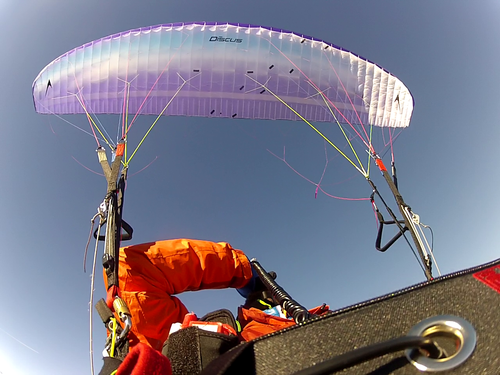Swing Discus M |
|||||||||||||||||||||||||||||||||||||||||||||||||||||||||||||||||||||||||||||||||||||||||||||||||||||||||||||||||||||||||


|
|||||||||||||||||||||||||||||||||||||||||||||||||||||||||||||||||||||||||||||||||||||||||||||||||||||||||||||||||||||||||
Instability rating |
|||||||||||||||||||||||||||||||||||||||||||||||||||||||||||||||||||||||||||||||||||||||||||||||||||||||||||||||||||||||||
|
|||||||||||||||||||||||||||||||||||||||||||||||||||||||||||||||||||||||||||||||||||||||||||||||||||||||||||||||||||||||||
Glider characteristics |
|||||||||||||||||||||||||||||||||||||||||||||||||||||||||||||||||||||||||||||||||||||||||||||||||||||||||||||||||||||||||
|
Launch preparations: easy
launch characteristics: balanced, delayed climb, needs gentle guidance, good feedback during inflation, little braking required, slows before zenith, control check simple, low takeoff speed
asymmetric collapse: moderate dynamics, total course change 180-270°, (3), moderate course change rate, moderate forward pitching 45-60°, (2), high height loss 40-49 m, (3), moderate sink velocity 15-19 m/s, (2), G-Force 2,5- 2,9 G, (2)
Frontal collapse: canopy collapses with high total collapse aera, low pitch backwards <30°, low pitch forwards <30°, moderate dynamics, course change <90°, (2), variable recovery behaviour, at times immediate, at times delayed, automatic recovery, (3), usually symmetric recovery, delayed return to normal airspeed, delayed reinflation of wingtips, moderate height loss 30-39 m, (2), low sink velocity 10-14 m/s, (1)
Spiral dives: moderate sink velocity increase, Low G-Force 3,0- 3,5 G, (1), Sink velocity after 720° <18 m/s, (3), High maximum sink velocity < 22 m/s, (3), sink velocity increase < 6 m/s on brake release, (2), Course change 360-540° after spiral exit, (3), high height loss during recovery 60-100 m, (3)
B-Stall: normal force required, marked pitch backwards 30-45°, moderate pitch forwards 15-30°, stable sink phase, low deformation tendency, immediate return to normal airspeed, 8-10 m/s, height loss on recovery < 20 m
big ears: simple initiation, stable flight phase, immediate automatic recovery, Vsink unaccelerated 2,5-3 m/s, Vsink accelerated 3-3,5 m/s, Vunaccelerated 3-5 km/h less than trimspeed, Vaccelerated 3-5 km/h faster than trimspeed
Steering behaviour: dampened to balanced, 75 cm brake travel range, Noticable brake pressure increase, normal stall point, easily identifiable |
|||||||||||||||||||||||||||||||||||||||||||||||||||||||||||||||||||||||||||||||||||||||||||||||||||||||||||||||||||||||||
Notes |
|||||||||||||||||||||||||||||||||||||||||||||||||||||||||||||||||||||||||||||||||||||||||||||||||||||||||||||||||||||||||
|
Swing's Discus have uncomplicated riser sets with no associated difficulties, line sorting was simple. Launch characteristics: Swing's Discus climbs slowly, which is not a disadvantage on steep launch sites. On flatter starts, the canopy needs a marked impulse to inflate and then constant guidance to the zenith, otherwise it tends to hang behind the pilot. On reaching the zenith, only a little brake is required to stabilise it there. Asymmetric Collapse: Swing's Discus requires a few meters more to recover from extreme accelerated collapses, and shows a tendency for collapses on the opposite wingtip but with no significant course change. Total course change for the manoeuvre was somewhat more than for the other A-class gliders in the test. Front Collapse: Swing's Discus also recovery well for larger front stalls. Occasionally both gliders do remain closed for longer periods which can lead to height losses of 40 m or more. Spiral Dive: Swing's Discus have a sink velocities around 15 m/s after the second turn, with exiting after a short acceleration phase and course changes of 180-270°. Exit behavior is somewhat challenging for the LTF-A class. B-Stall: Swing's Discus is a little unstable during the stall phase, and tends to slowly deform such that the wingtips fall back behind. Big Ears: Very easy, wingtips stable, no flapping. |
|||||||||||||||||||||||||||||||||||||||||||||||||||||||||||||||||||||||||||||||||||||||||||||||||||||||||||||||||||||||||
Rating |
|||||||||||||||||||||||||||||||||||||||||||||||||||||||||||||||||||||||||||||||||||||||||||||||||||||||||||||||||||||||||
|
Safety class 3 This class of paraglider react moderately to one or more of the following manoeuvres: frontal collapse, asymmetric collapse or spiral dive.Moderately means that the above manoeuvres result in dynamic reactions from the glider and/or large height losses. Good piloting skills which need to be regularly practised, together with good personal reaction times which are above basic training levels are required to safely fly this class of gliders. Skill and experience levels greater than those attained in basic training are required to safely recover from the above manoeuvres. Emergency descent manoeuvres, in particular spiral dives may require advanced recovery skills. Additional training such as regular ground handling or SIV training is recommended. |
|||||||||||||||||||||||||||||||||||||||||||||||||||||||||||||||||||||||||||||||||||||||||||||||||||||||||||||||||||||||||

